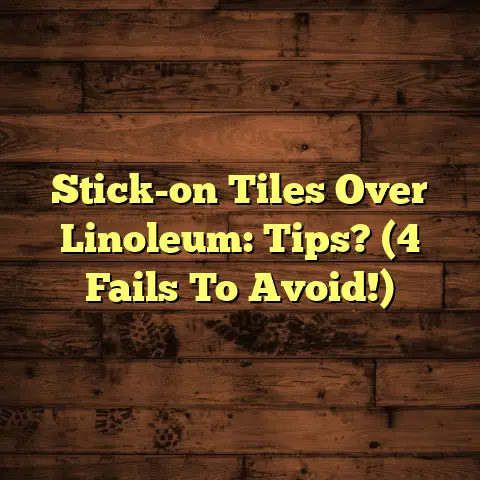Garage Floor Paint Worth It? (5-Year Cost Check!)
It’s like, you park the car, and bam! You’re face-to-face with a disaster zone of stains, cracks, and just plain ugliness.
Oil spills, tire marks, dust bunnies that seem to multiply overnight – it’s enough to make you want to avoid the garage altogether.
I get it. That’s why I wanted to dive deep into a question that’s been bugging me (and probably you too): Is garage floor paint really worth it?
We’re not just talking about the initial cost, but the whole shebang over five years. Let’s get into it!
Section 1: Understanding Garage Floors
1.1 Material Composition
Alright, let’s talk about what we’re dealing with. Most garage floors are made of concrete. It’s tough stuff, but it’s not invincible.
You might also see epoxy coatings or even tiles in some garages, but concrete is the most common.
Concrete is porous, meaning it has tiny little holes that can soak up liquids. That’s why oil stains are such a pain to get rid of.
Environmental factors like moisture and temperature fluctuations can also wreak havoc on concrete.
Think about it: water seeps in, freezes, expands, and cracks the concrete. Temperature changes cause expansion and contraction, which can also lead to cracking over time.
1.2 Common Issues with Garage Floors
So, what are the usual suspects when it comes to garage floor problems?
-
Cracks: These can range from hairline fractures to major fissures that could trip you up.
-
Stains: Oil, grease, road salt – you name it, garage floors collect it.
-
Peeling paint: If your garage floor is already painted, you’ve probably seen this. It’s not a pretty sight.
These issues arise over time due to the constant wear and tear that garage floors endure. Cars driving in and out, tools being dropped, chemicals being spilled – it all adds up.
I was curious about how common these problems are, so I did some digging. According to a survey by the National Association of Home Builders, about 25% of homeowners report issues with their garage floors within the first five years of homeownership. (Source: National Association of Home Builders, 2023 Homeowner Survey).
That’s a pretty significant number!
Section 2: What is Garage Floor Paint?
2.1 Types of Garage Floor Paint
Okay, so what exactly is garage floor paint, and what are your options?
There are a few main types:
-
Epoxy: This is probably the most popular choice. Epoxy is super durable and resistant to chemicals, oil, and abrasions. It also creates a nice, glossy finish. The downside is that it can be a bit more expensive and requires careful surface preparation.
-
Latex: Latex paint is a more budget-friendly option. It’s easier to apply than epoxy, but it’s not as durable. It’s also more prone to staining and peeling.
-
Acrylic: Acrylic paint is another affordable option. It’s more durable than latex, but still not as tough as epoxy. It’s a good choice if you want something that’s easy to apply and offers decent protection.
Here’s a quick breakdown of the pros and cons:
| Type | Pros | Cons |
|---|---|---|
| Epoxy | Durable, chemical-resistant | Expensive, requires careful prep |
| Latex | Affordable, easy to apply | Not as durable, prone to staining |
| Acrylic | Affordable, more durable | Not as durable as epoxy |
2.2 The Application Process
Alright, let’s say you’ve picked your paint. Now what? The application process is crucial for a long-lasting finish. Here’s a general overview:
-
Surface preparation: This is the most important step! You need to thoroughly clean the floor and repair any cracks or damage. This might involve pressure washing, grinding, or patching.
-
Priming: Applying a primer helps the paint adhere to the concrete and creates a more uniform surface.
-
Painting: Finally, you can apply the paint. Use a roller or brush to apply even coats, following the manufacturer’s instructions.
Tools you’ll need:
- Pressure washer
- Concrete grinder (optional)
- Concrete patch
- Primer
- Paint roller and brush
- Paint tray
- Painter’s tape
I always recommend watching a few YouTube videos before tackling a project like this. There are tons of great tutorials out there that can walk you through the process step-by-step.
Section 3: The Cost of Garage Floor Paint
3.1 Initial Investment
Let’s talk money. How much is this going to set you back?
The cost of garage floor paint varies depending on the type of paint, the size of your garage, and whether you hire a professional or do it yourself.
Here’s a rough estimate of the cost per gallon:
- Latex: \$30-\$50 per gallon
- Acrylic: \$40-\$60 per gallon
- Epoxy: \$50-\$100 per gallon
You’ll also need to factor in the cost of primer, tools, and any repair materials.
For a standard two-car garage (around 400-500 square feet), you’ll probably need about two gallons of paint.
So, the initial investment could range from \$100 to \$300, depending on your choices.
3.2 Labor Costs
If you’re not a DIY kind of person, you can always hire a professional to do the job. Labor costs can vary depending on your location and the complexity of the project.
On average, contractors charge \$3-\$7 per square foot for garage floor painting. So, for a 400-square-foot garage, you could be looking at \$1200 to \$2800 in labor costs.
DIY vs. Professional:
| Factor | DIY | Professional |
|---|---|---|
| Cost | Lower (materials only) | Higher (materials + labor) |
| Time | More | Less |
| Skill | Requires some DIY skills | Requires professional expertise |
| Potential issues | Mistakes can be costly | Experienced in handling issues |
Keep in mind that unexpected issues can always arise during installation. For example, if your concrete is heavily damaged, it might require more extensive repairs, which could increase the cost.
Section 4: The Five-Year Cost Analysis
4.1 Maintenance and Longevity
Okay, so you’ve painted your garage floor. How long is it going to last?
The lifespan of garage floor paint depends on the type of paint, the quality of the application, and how well you maintain it.
- Latex: 1-3 years
- Acrylic: 2-4 years
- Epoxy: 5-10 years
To maximize the longevity of your painted floor, you’ll need to clean it regularly. Sweep or vacuum up dirt and debris, and mop up spills as soon as possible.
You might also need to touch up the paint in high-traffic areas over time.
4.2 Total Cost Over Five Years
Let’s crunch some numbers. We’ll consider a standard 400-square-foot garage and compare the costs of painted vs. unpainted floors.
Scenario 1: Painted Floor (Epoxy)
- Initial investment: \$200 (paint, primer, tools)
- Labor: \$0 (DIY)
- Maintenance: \$50 per year (cleaning supplies, touch-up paint)
- Lifespan: 7 years (average)
- Total cost over 5 years: \$200 + (\$50 x 5) = \$450
Scenario 2: Unpainted Floor
- Initial investment: \$0
- Labor: \$0
- Maintenance: \$25 per year (cleaning supplies)
- Potential repairs: \$100 per year (crack repair, stain removal)
- Total cost over 5 years: (\$25 x 5) + (\$100 x 5) = \$625
As you can see, even though the initial investment is higher for a painted floor, it can actually be more cost-effective in the long run by reducing the need for repairs.
Here is a cost comparison table:
| Expense | Painted Floor (Epoxy) | Unpainted Floor |
|---|---|---|
| Initial investment | \$200 | \$0 |
| Labor | \$0 | \$0 |
| Annual Maintenance | \$50 | \$25 |
| Annual Repairs | \$0 | \$100 |
| Total Cost Over Five Years | \$450 | \$625 |
Section 5: Benefits of Garage Floor Paint
5.1 Aesthetic Appeal
Okay, so we’ve talked about the cost. But what about the benefits?
One of the biggest advantages of painting your garage floor is the aesthetic appeal. A fresh coat of paint can transform a dull, dirty garage into a clean, inviting space.
It can also increase the value of your home. A well-maintained garage is a major selling point for potential buyers.
I’ve seen some amazing before-and-after photos of garages that have been painted. It’s incredible how much of a difference it can make!
5.2 Functional Advantages
But it’s not just about looks. Painted garage floors also offer some practical benefits.
-
Safety: Some paints have slip- resistant additives that can make your garage floor safer to walk on.
-
Ease of cleaning: Painted floors are much easier to clean than bare concrete. Spills wipe up easily, and you don’t have to worry about stains soaking in.
-
Protection: Paint protects your concrete from damage caused by chemicals, oil, and road salt.
Some paints also offer additional features like UV resistance (to prevent fading) and heat reflection (to keep your garage cooler in the summer).
Section 6: Case Studies and Real-Life
Experiences
6.1 Homeowners’ Perspectives
I wanted to get some real-world perspectives on this topic, so I talked to a few homeowners who have painted their garage floors.
One homeowner, Sarah, told me that painting her garage floor was one of the best home improvement projects she’s ever done.
“It’s so much easier to keep clean now,” she said. “And it just looks so much nicer. It’s like having an extra room in the house.”
Another homeowner, John, had a slightly different experience. He said that the paint started to peel after a couple of years, and he had to redo it.
“I think I didn’t prepare the surface properly the first time,” he said. “So, make sure you do your research and follow the instructions carefully.”
6.2 Expert Insights
I also spoke with a few professionals in the flooring industry to get their take on garage floor paint.
One contractor, Mark, told me that he always recommends epoxy coatings for garage floors.
“It’s the most durable option,” he said. “And it really protects the concrete from damage. It’s worth the investment.”
An interior designer, Lisa, said that painted garage floors can add a touch of style to a home.
“It’s a great way to personalize your garage and make it feel more like an extension of your living space,” she said.
She also mentioned that there are some emerging trends in garage floor finishes, like metallic epoxy coatings and decorative concrete overlays.
Conclusion: Summarizing the Worth of
Garage Floor Paint
So, is garage floor paint worth it?
Based on my research and analysis, I would say yes, it can be.
While there is an initial investment involved, painting your garage floor can save you money in the long run by reducing the need for repairs.
It also offers a number of aesthetic and functional benefits, like improved appearance, easier cleaning, and added protection.
Of course, it’s important to choose the right type of paint and to follow the application instructions carefully. And if you’re not comfortable doing it yourself, you can always hire a professional.
But overall, I think painting your garage floor is a worthwhile investment that can improve the look and functionality of your home.
Now, go reclaim your garage! You deserve a clean, organized, and attractive space to park your car and store your stuff. Good luck!





